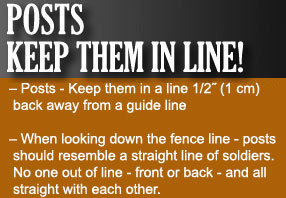Fence Specifications
Horserail guidelines for building rail and coated wire horse fencing.
Content
Post Spacing
The ideal post spacing for horse fences depends on the type and pressure. Rail fences are typically set 8–12 feet apart, while coated wire fences range from 8–20 feet. Heavier pressure areas require closer spacing to maintain strength, while lighter pressure allows for wider spacing.
Our spacing guide recommendations are:

- Lots (Heavy Pressure): Rail 8′ (245cm) , Coated Wire 8′ (245cm)
- Pasture (Medium Pressure): Rail 10′ (305cm) , Coated Wire 16′ (490cm)
- Range (Average Pressure): Rail 12′ (365cm) , Coated Wire 20′ (610cm)
- Light Grazing: Rail 12′ (365cm) , Coated Wire 20′ (610cm)
Extra rails and closer post spacing may cost more, but the additional density increases the substantiality of the fence.
Fence Height
Recommended horse fence height is 54″ (1.4 m). For arenas, turnout lots, or corrals where horses face more pressure and may attempt to jump, posts should be taller, typically 5′ to 6′ (1.5–1.8 m), to ensure safety and secure containment.
Post Sizing
Whatever height is chosen, the appropriate post length must be used:

Line:
Diameter: 4″-5″ (107mm-127mm)
Length: soft 8′ (245cm) | concrete 7′ (215cm)
Inbedment: Min. 2.5′ (76cm)
Corner:
Diameter: 5″-6″ (127mm-152mm)
Length: soft 9-10′ (275cm-305cm) | concrete 8′ (245cm)
Inbedment: 3.5′-4′ (107cm-122cm)
End/Gate:
Diameter: 7″-8″ (178mm-203mm)
Length: soft 9-10′ (305cm-365cm) | concrete 8′ (245cm)
Inbedment: 4.5′-5′ (137cm-152cm)
*Frost depth must be considered.
*Use consistent measurements. Please confirm recommended fence parameters.

Frequently Asked Questions:
How far apart should rails be on a horse fence?
Rails are typically spaced 7″ to 11″ (18-28cm) apart, depending on the number of rails used. This amount of spacing discourages horses from reaching through the fence and reduces the risk of foot, leg, and head entrapment. Wider spacing can be achieved in electric fencing since horses avoid the fence.
How much ground clearance should a horse fence have?
The bottom rail of a horse fence should have about 12″ (30cm) of clearance from the ground. This height helps prevent animals from going under the fence and allows for mower access.
How many rails do you need for a horse fence?
Most horse fences use 3 or 4 rails. Three rails are common for pastures and general containment, while four rails adds coverage especially in taller fences, making them ideal for foals, stallions, or high-value horses. The right choice depends on safety needs, property layout, and horse behavior.
What is the correct 3-rail post spacing?
A 3-rail horse fence typically uses posts set 8′ to 10′ (2.4–3m) apart, with rails spaced evenly to create strong visibility and security. This layout balances cost and durability, while keeping horses safely contained. For higher pressure areas, tighter 8-foot spacing is recommended to maintain long-term fence strength.
What is the correct 4-rail post spacing?
Most 4-rail horse fences use 10′ (3m) post spacing. In high-pressure areas, posts should be set closer at 8′ (2.4m) to increase strength and safety. In lower-pressure areas, spacing can extend to 12′ (3m) without sacrificing effectiveness.
Getting an Estimate for Your Fence
The next step may be to find out what the plan is going to cost. We suggest that you get an armful of stakes and go out and mark out where you want fences and gateways. Measure-up, draw a rough sketch and write down the measurements. To get help and an estimate for your horse fencing click here.